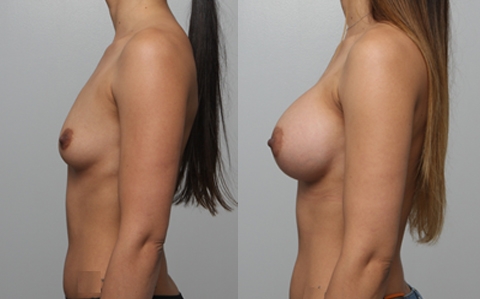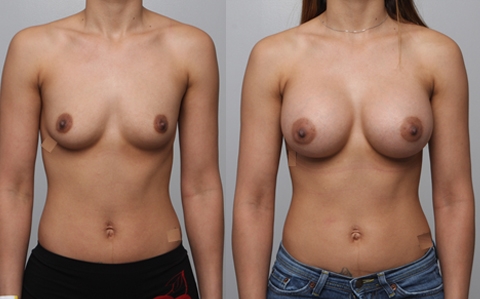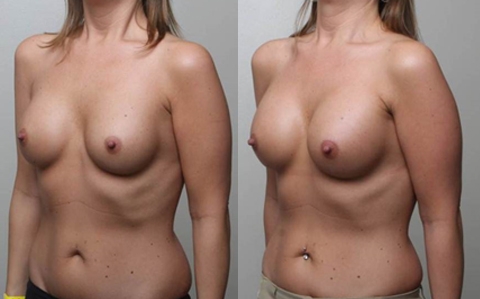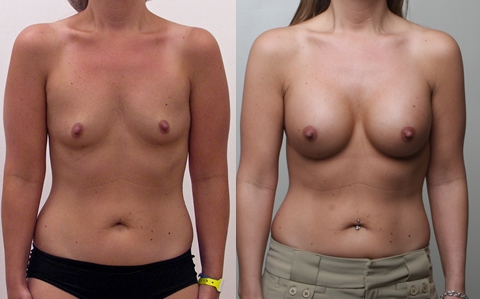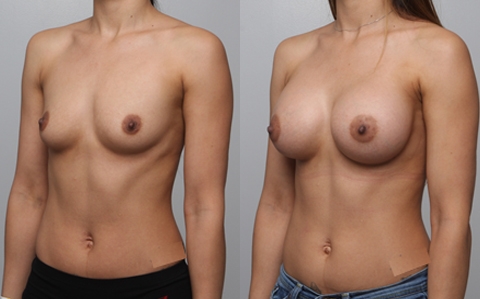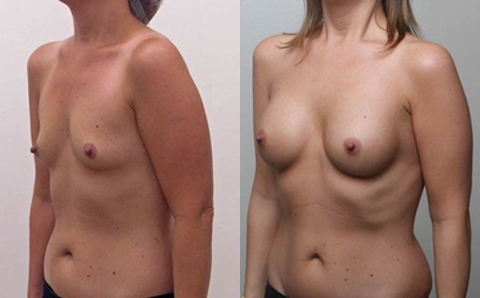Breast Augmentation Surgery Overview
Breast implants are performed to enlarge small breasts, underdeveloped breasts, or breasts that have decreased in size after childbearing. Drs. Pelosi will help you determine the most effective surgical approach following a thorough examination of your breasts. They will discuss with you the various alternatives of anesthesia available for your case, they will describe the surgical procedure, what results as expected, and the possible risks and complications.
What Breast Augmentation Can Do:
Breast Augmentation can:
- Increase fullness and enhance the projection of your breasts
- Improve breast shape and symmetry
Breast augmentation cannot:
- Lift or improve severely sagging breasts (a breast lift may be required)
QUICK LINKS
Who’s An Ideal Candidate For Breast Augmentation Surgery?
You may be a candidate for breast augmentation if:
- You’re physically in good health.
- Have realistic expectations.
- You’re unhappy with the shape or size of your breasts.
- You’re breasts are asymmetrical.
- You’re unhappy with the shape or size of your breasts after pregnancy, weight loss or aging.
Breast Augmentation Considerations?
Breast augmentation is a highly-personalized surgery and there are many considerations including:
- Surgical approach
- Implant Size & Volume
- Site of the incision.
- Placement of implant: Above or below the muscle
- Implant Shape: Round or Teardrop
- Implant Surface: Smooth or Textured
- Implant Material: Silicone vs. Saline
- Implant Projection: Standard vs. High
Before & After Gallery
201.858.1800
Schedule Your Consultation
Meet The Doctors
DR. PELOSI II
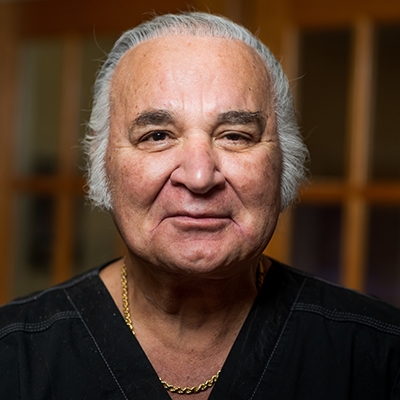
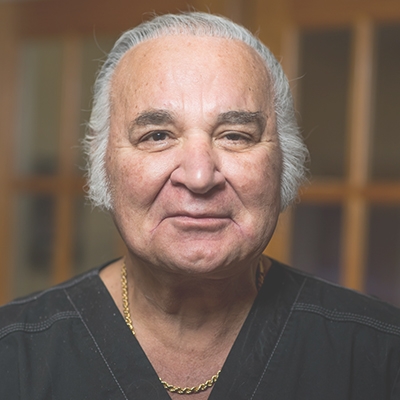
DR. PELOSI III


201.858.1800
Schedule Your Consultation
Site of Incision
The incision site of your breast augmentation can be made:
- At the belly button
- Under the breast crease
- Boarder of the nipple/areola
- Through the axilla (armpit)
We tend to favor the axilla because those scars will never keloid. And it gives a great cleavage because of the angle that the implant is being inserted. The recovery is also relatively faster than the other incisions.
Above or Below the Muscle
Another consideration patients have is the location of the implant (above vs. below the muscle). Placing the implant under the muscle, tends to give a more natural cleavage. Whereas, placing them above the muscle is usually a better option if the breasts are slightly sagging. Some sagging breasts need a breast lift, but the ones that don’t can be managed with breast augmentation with a larger implant. Sometimes it looks better if the implant is placed above the muscle so the loose breast tissue can be stretched out maximally.
Recovery After Your Breast Augmentation Surgery
On the day of surgery you will feel sleepy and may feel pain or be nauseated. Your chest may feel tight and uncomfortable. Your arms and back may also be sore. Pain medication will be prescribed to minimize your discomfort.
After surgery your breasts will be very firm, high, and swollen. After about a month, the swelling will be gone and they will be lower, smaller, and softer. It may take several months for the implants to settle into a permanent position.
Key Facts About Your Breast Augmentation Recovery
Typical Duration: 1 hour
Work: 2-3 days
Exercise: 4-6 weeks
Final Results: 2-3 months
Breast Augmentation with Fat Transfer
An alternative option to breast implants is breast augmentation with fat transfer.
In the past breast augmentation using fat injections was frowned upon by breast surgeons because of the pressure of fat necrosis (a frequent benign breast tissue change resulting from the fat transfer) would interfere with breast cancer detection. But MRI technology changed that because the MRI can determine the difference between fat necrosis and cancerous tissue.
The advantages of breast augmentation with fat transfer include:
- Less expensive
- Minimally invasive with less trauma to the breast
- No visible scars
- Can be done as an office procedure totally under local anesthesia
- Avoids tissue or foreign material (implants) rejection because the fat is an autologous graft
- Fewer postoperative complications
- Touch up procedures are easily performed
- Fat transfer does not make the performance on a future breast implant placement more difficult
Frequently Asked Questions About Breast Augmentation
With a high-profile implant, the liquid volume is the same as a standard implant but its diameter (footprint) is narrower and the projection (the amount it protrudes out and away from your body) is greater.
Most women are better candidates for standard implants. If the diameter of the implant size (standard implant) you selected is about the same as, or smaller than, your measured breast diameter, then a standard implant is your best choice. If the diameter of the desired breast implant size is larger than your breast diameter, then a high-profile breast implant is best.
The FDA has recently approved silicone gel breast implants for use in primary breast augmentation for any woman over the age of 22. The main disadvantages include a possible higher rate of capsular contracture, the incision to place the implant is larger than the one needed for placement of a saline implant, and the cost is substantially higher then saline breast implants. On the other hand, they provide the most natural look and feel ideally suited for women with a modest amount of breast volume.
Breast implants are available in various sizes ranging from 200 – 600 ml. The range 300 – 450 ml is the most common. Choosing your desired size can be a difficult decision – it is highly personal.
You can determine the size you want by placing breast implant sizers in your bra and then putting on a sweater, blouse or a t-shirt. You’ll want to decide your cup size and that will determine how large your implant will be. A 400 ml implant placed in a woman with an A cup will produce a C cup. The same implant placed in a woman with a B cup will produce a D cup. Bring the pictures of your desired size (take a look at a lingerie catalog or swimsuit pictures) to your consultation. Take the time to decide what you will be happy with so you don’t feel the need to undergo a second surgery.
Each saline implant must be overfilled by an additional 25-30 ml. This technique decreases the risk of deflation, rippling, and sloshing. There are no disadvantages to overfilling. Implants are meant to be overfilled, and the implant manufacturers recommend surgeons to overfill them.
Textured implants are rough, similar to sandpaper. They were developed to decrease the risk of capsular contracture. However, studies have not shown a consistent advantage over smooth implants regarding capsular contracture. They have an increased risk of rippling, have a higher deflation rate and are firmer than smooth implants. They are also more expensive. Most breast cosmetic surgeons favor smooth implants.
Round implants are shaped like jelly donuts. They are not affected by rotation and cost less than teardrop implants. There are no disadvantages to round implants. It is favored by most cosmetic breast surgeons. Teardrop implants are shaped more like the breast. The teardrop implant may rotate, creating a distorted breast shape. It also requires a textured surface to prevent rotation.
The standard placement of breast implants, regardless of the incision site, is essentially a blind operation that makes intraoperative visualization of the surgical area difficult for purposes of dissection of tissue planes, for the accurate division of muscle fibers, and the control of bleeding. The use of illuminated surgical retractors has offered only a partial visualization solution
The introduction of the endoscope has substantially improved the accuracy and predictability of breast enlargement with breast implant surgery. The addition of the endoscope has been is a major breakthrough in the area of cosmetic surgery including breast augmentation.
The ideal incision site to perform breast endoscopic augmentation is the armpit. The endoscopic transaxillary augmentation allows the cosmetic surgeon to create crease symmetry, muscle division, implant positioning and bleeding control under total endoscopic visualization with great control and ease.
The performance of a safe and effective endoscopic transaxillary augmentation procedure requires expertise with the use of the endoscope. Drs. Pelosi pioneering work and expertise with endoscopic surgery (laparoscopy, hand-assisted laparoscopy and hysteroscopy) are recognized worldwide.
Although Drs. Pelosi consider the armpit the best approach for the endoscopic breast augmentation, at a patient’s request, they are also able to perform the endoscopic surgery using the inframammary and the belly button incisions.
The options for site of incision are underneath your breasts (inframammary), around the nipple (periareolar), in the armpit (transaxillary) or through the belly button (TUBA or trans-umbilical breast augmentation). All these approaches have advantages and disadvantages.
Underneath the breast (inframammary)
The inframammary incision under the breast is placed within or near the crease beneath the breast, the scar is usually hidden under the breast. This incision can sometimes become lumpy and could become very visible.
The inframammary incision under the breast is placed within or near the crease beneath the breast, the scar is usually hidden under the breast. This incision can sometimes become lumpy and could become very visible.
Trans-umbilical Breast Augmentation (TUBA)
When the incision is placed through the belly button (TUBA), the incision is hidden inside the belly button. The technique requires an experienced surgeon in order to avoid breast implant rupture during placement, undercorrection of certain breast asymmetries, incomplete control of shape, and bleeding. When properly performed, it is an excellent scarless alternative to the other type of incisions.
The transaxillary approach is extremely popular with many patients because the incisions can be made smaller and they are almost invisible (they are hidden in the skin crease in the top of the armpit.)
Advantages:
- Less interference with a mammogram
- Less rippling appearance in the upper half of the breasts
- More cushion between the implant and the skin
- Ideal for thin and small-breasted women
Disadvantages:
- Not well suitable for large breasted women
- Worse cosmetic result are seen in athletic women
Advantages:
- Less postoperative discomfort and swelling.
- Lower chance that the breast will appear to move when the patient exercises the upper body.
Disadvantages:
- Greater risk of visible rippling appearance of the breast.
- Worst cosmetic results are seen in women with small breasts.
LET'S BE SOCIAL
@PelosiMedicalCenter
[instagram-feed]
CONTACT US
(201)858-1800
Monday to Friday
9:00am – 5:30pm
VISIT US
350 Kennedy Boulevard
Bayonne, NJ 07002
